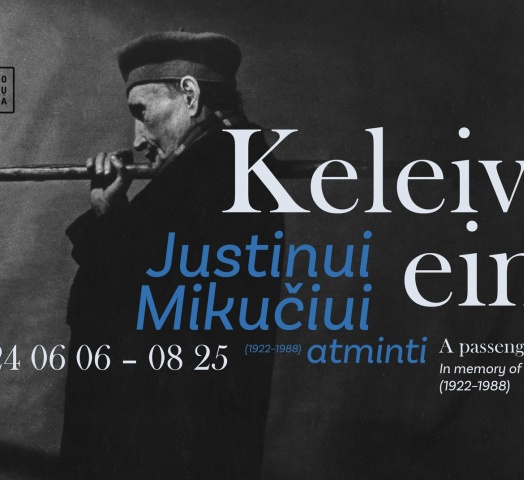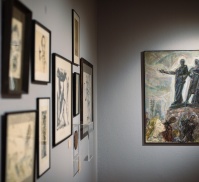"A Passenger on the Move". In memory of Justinas Mikutis (1922–1988)" at Kaunas Picture Gallery
This exhibition is a story about Justinas Mikutis, a symbol of civil disobedience in Soviet Lithuania. For his profound insights, he was called and still is remembered as a philosopher, a thinker, even a prophet. In an atmosphere of fear and uncertainty, many artists admired the freedom of his thought. His erudition contrasted with the primitiveness of official ideology. Socially, he was a marginal whose life was not in line with normal way of being, he did not care about comfort, instead, he himself was uncomfortable for others. After a decade‘s imprisonment in a Siberian camp, he returned crippled, was deeply affected by the traumatic experience, but his posture radiated the courage of a man who had no fair of the system, there was nothing to lose. An artwork by painter Arvydas Šaltenis was lent to this exhibition by TARTLE.
The title of the exhibition is a quotation from the poet Vytautas Mačernis' poem Miražai (Mirages), 1937. "A Passenger on the move" is a fitting description of Justinas' constant state of mind: he was always on the move – frequenting his friends‘ homes, staying in artists' workshops, visiting his relatives, accompanying artists during their gatherings in Samogitia.
The story begins in Christian Samogitia and describes places that attracted artists and outsiders during the Soviet era. Their travel experiences are revealed through folk art objects and professional works from Beržoras, Gintališkės, Notėnai – places in Samogitia that have retained their ethnographic identity and are therefore of great importance to artists. In the 1970s and 1980s, the homestead of artists Barbora and Vladas Didžiokas in Dovainonys near Rumšiškės became an attraction for young artists seeking seclusion. The atmosphere of this place, objects, meetings, moods have been captured in photographs and paintings.
The part Trajectories of Freedom presents works dating back to the 1950s until the present day. These are portraits and dedications created by artists who resisted the official rules of Soviet art. Mikutis' influence on artists' values is even more pronounced in works created after the fall of the empire and in the years of the restored independence.
Another group of works illustrate the time when Justinas was posing at the Vilnius Institute of Art (now VAA). Mikutis valued the communion of students, calling them "perhaps the only rays of light in his foggy and frustrated life".
One of the more important memorabilia on display is Mikutis' criminal file from the Lithuanian Special Archive. It is likely to embody the feelings of many people who have endured the trials of repression. The exhibition is complemented by Mikutis' thoughts from his manuscripts and letters, also poetic metaphors by other authors (Vytautas Mačernis, Leonardas Gutauskas, Sigitas Geda) used in the titles of the paragraphs.

This exhibition is a story about Justinas Mikutis, a symbol of civil disobedience in Soviet Lithuania. For his profound insights, he was called and still is remembered as a philosopher, a thinker, even a prophet. In an atmosphere of fear and uncertainty, many artists admired the freedom of his thought. His erudition contrasted with the primitiveness of official ideology. Socially, he was a marginal whose life was not in line with normal way of being, he did not care about comfort, instead, he himself was uncomfortable for others. After a decade‘s imprisonment in a Siberian camp, he returned crippled, was deeply affected by the traumatic experience, but his posture radiated the courage of a man who had no fair of the system, there was nothing to lose. An artwork by painter Arvydas Šaltenis was lent to this exhibition by TARTLE.
The title of the exhibition is a quotation from the poet Vytautas Mačernis' poem Miražai (Mirages), 1937. "A Passenger on the move" is a fitting description of Justinas' constant state of mind: he was always on the move – frequenting his friends‘ homes, staying in artists' workshops, visiting his relatives, accompanying artists during their gatherings in Samogitia.
The story begins in Christian Samogitia and describes places that attracted artists and outsiders during the Soviet era. Their travel experiences are revealed through folk art objects and professional works from Beržoras, Gintališkės, Notėnai – places in Samogitia that have retained their ethnographic identity and are therefore of great importance to artists. In the 1970s and 1980s, the homestead of artists Barbora and Vladas Didžiokas in Dovainonys near Rumšiškės became an attraction for young artists seeking seclusion. The atmosphere of this place, objects, meetings, moods have been captured in photographs and paintings.
The part Trajectories of Freedom presents works dating back to the 1950s until the present day. These are portraits and dedications created by artists who resisted the official rules of Soviet art. Mikutis' influence on artists' values is even more pronounced in works created after the fall of the empire and in the years of the restored independence.
Another group of works illustrate the time when Justinas was posing at the Vilnius Institute of Art (now VAA). Mikutis valued the communion of students, calling them "perhaps the only rays of light in his foggy and frustrated life".
One of the more important memorabilia on display is Mikutis' criminal file from the Lithuanian Special Archive. It is likely to embody the feelings of many people who have endured the trials of repression. The exhibition is complemented by Mikutis' thoughts from his manuscripts and letters, also poetic metaphors by other authors (Vytautas Mačernis, Leonardas Gutauskas, Sigitas Geda) used in the titles of the paragraphs.







